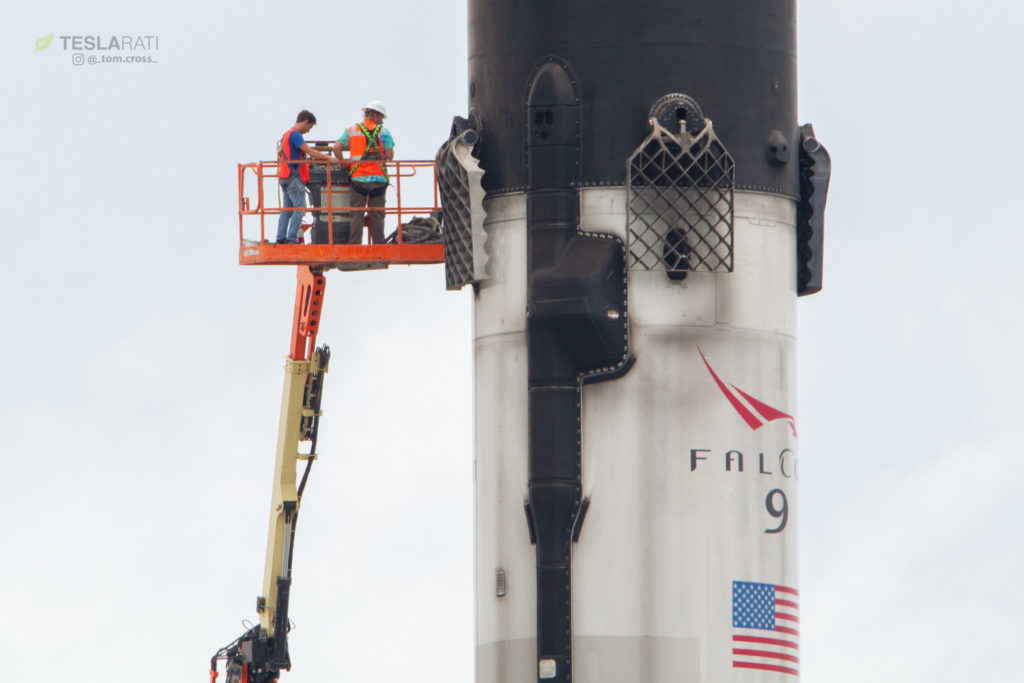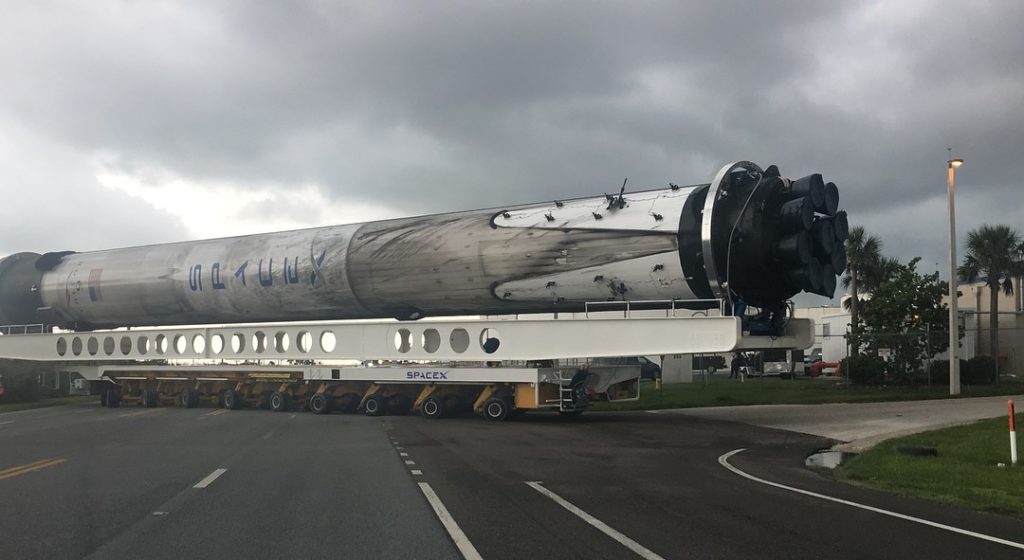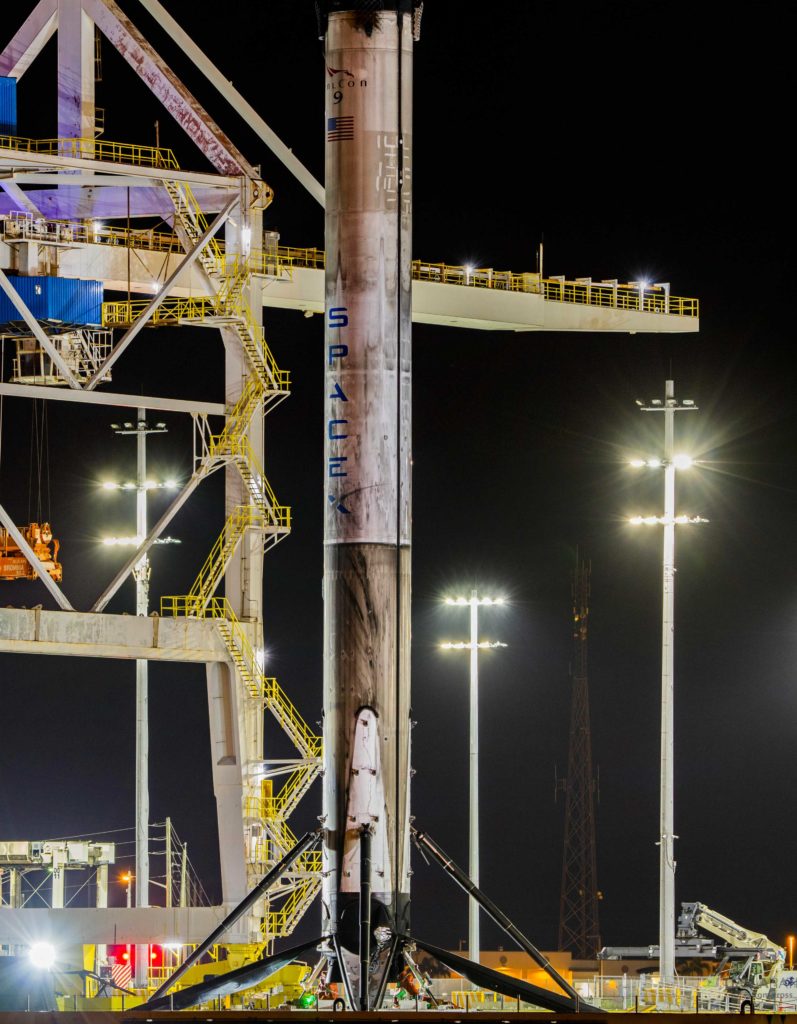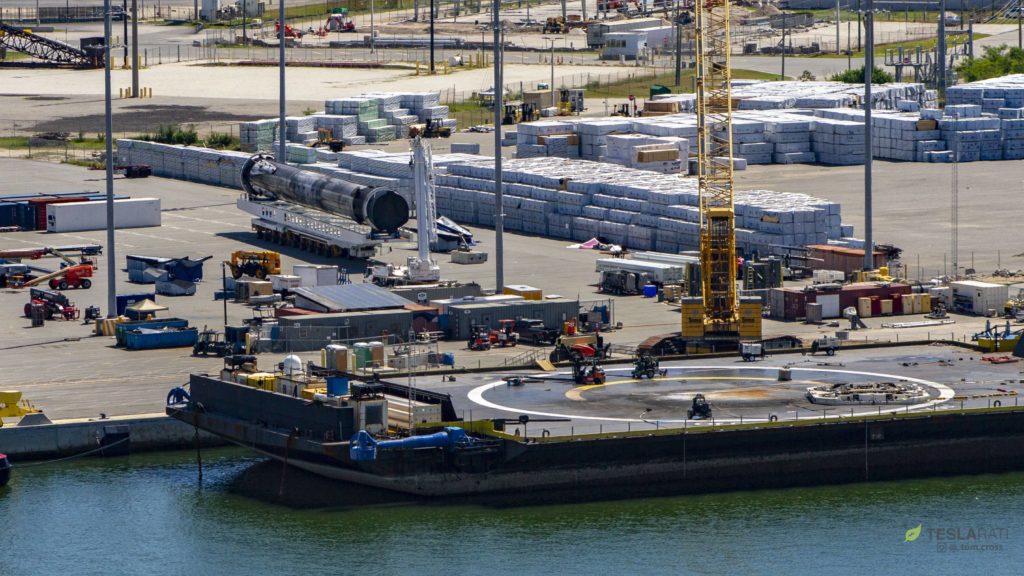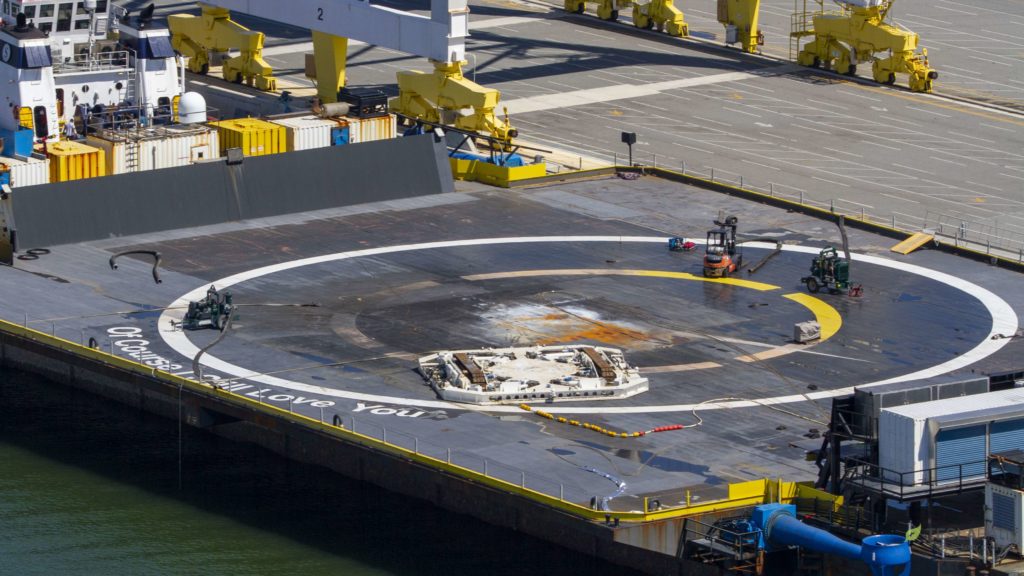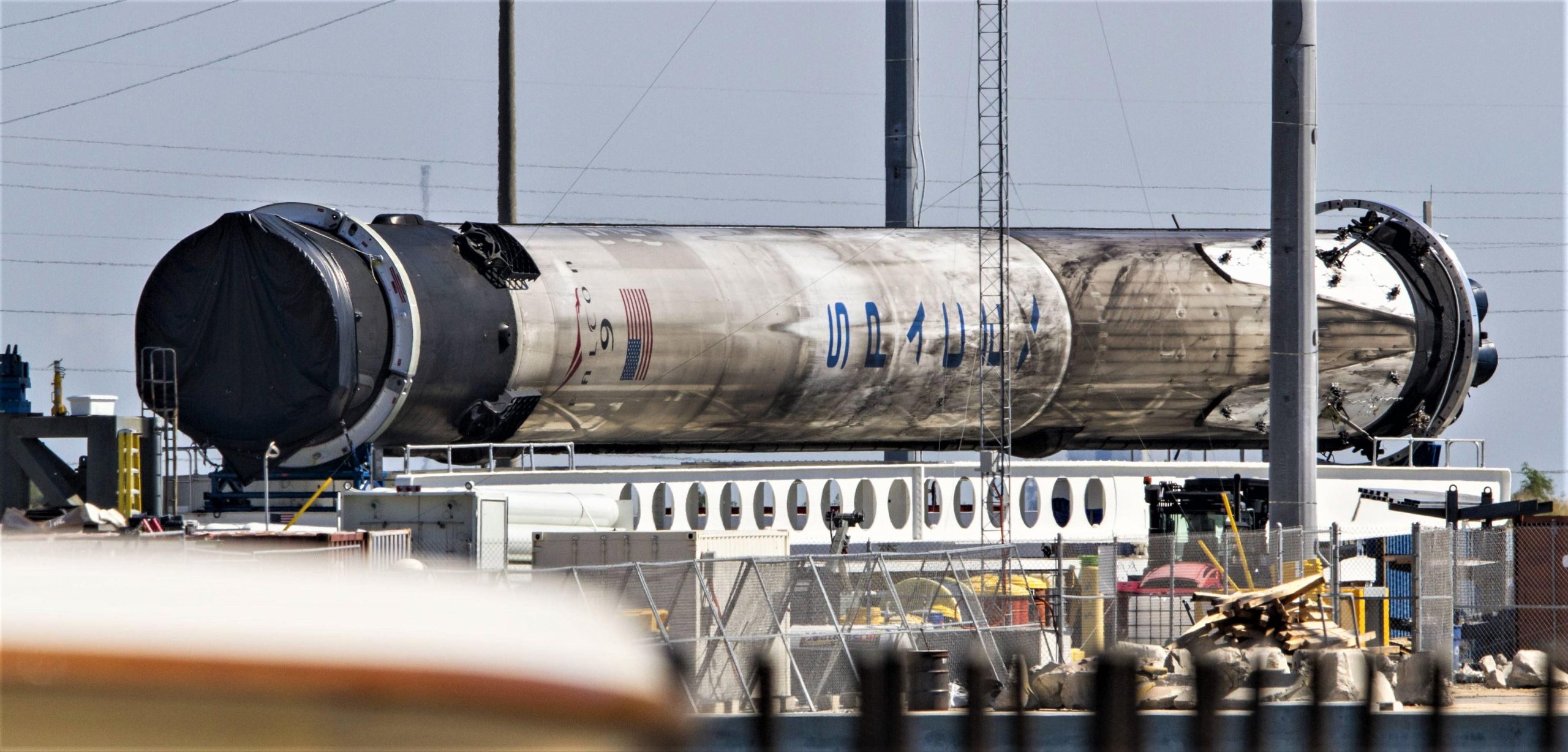
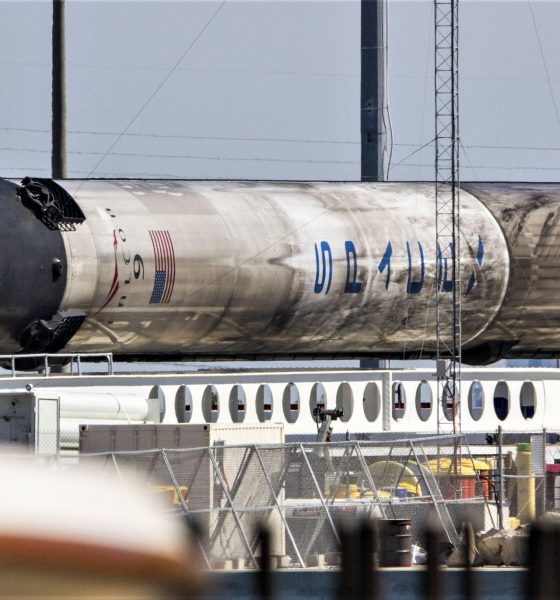
News
SpaceX’s Falcon 9 Block 5 rocket looks no worse for wear after dual launches
SpaceX’s first Falcon 9 Block 5 booster has returned to Port Canaveral, FL once again after the rocket’s second successful launch, likely the first of countless reuses to come over the next months and years. Of note, B1046.2 (Booster 1046, flight 2) was by all appearances in as good of condition as it was when it lifted off from Pad 40 just three days prior.
While it may be difficult to immediately distinguish between B1046’s second launch and recovery and those of previous, older Falcon 9 boosters, Block 5 is a quite simply an entirely different story. Moreover, the fact that SpaceX went from the major upgrade’s launch debut to first booster reflight in barely three months is an extraordinarily good indication that Block 5’s first flightworthy design (especially the parts not visible to the public) is very close to its engineers’ theoretical intentions.
Some additional shots of today's B1046.2 return to port. @SpaceX @SpaceXUpdates @elonmusk @SpaceXFleet #SpaceX pic.twitter.com/d4ivQ8PRuU
— The Aerospace Geek (@ThAerospaceGeek) August 10, 2018
Falcon 9 B1046’s second recovery also happened to be the quickest yet for SpaceX by a healthy margin, taking just 4.5 days to travel 400 miles back to port, be lifted off drone ship Of Course I Still Love You, have its legs removed, and be loaded horizontally onto SpaceX’s dedicated Cape Canaveral booster transporter. Whether or not the rocket itself is ready for another flight with absolutely zero refurbishing in between, this demonstration of just how quickly SpaceX’s infrastructure can operate indicates that much of the framework needed for truly rapid reuse is already largely in place.
Once SpaceX is confident that Block 5 can be reflown with little more than new fuel added and has lined up multiple payloads for launch in just a few days or weeks, it’s clear that the company will already have the ability to launch (and reuse rockets) so quickly that drone ship availability will become the primary bottleneck. For example, if B1046 could have shipped to one of SpaceX’s launch sites moments after it was loaded on its transporter and prepped for the second launch within 24-48 hours of going horizontal, it’s extremely unlikely that OCISLY could be readied for another booster recovery and towed several hundred miles off the coast in time to catch B1046 after its third launch.
- B1046 returned to Port Canaveral shortly after its May 4 debut, and is now being carefully analyzed as pathfinder hardware. (Tom Cross)
- Soon after, B1046 was spotted on its way to a refurbishment facility around a week after its May 11 launch debut. (Instagram /u/tersco)
- It’s currently unclear whether B1046 or B1048 will become the first SpaceX rocket to fly three times. (Tom Cross)
- 60 hours after docking, B1046 was loaded horizontally onto its transporter. (Tom Cross)
- SpaceX’s rocket-securing robot, known as Octagrabber, seen on OCISLY after another successful rocket recovery, August 12th. (Tom Cross)
As such, barring the extremely rapid completion of SpaceX’s third drone ship (named A Shortfall of Gravitas), it can be all but guaranteed that SpaceX will need to use its land-based Landing Zone 1 to accomplish CEO Elon Musk’s challenge of launching, landing, and relaunching the same Falcon 9 booster in less than 24 hours sometime before the end of 2019. Even then, it seems likely that SpaceX would either need to dramatically improve the turnaround capabilities of one of its launch sites or conduct those back-to-back launches using both of the company’s two Florida pads (LC-39A and LC-40).
Regardless, the first reuse of a Falcon 9 Block 5 booster unequivocally marks the beginning of a new era for SpaceX and for orbital rocketry worldwide. According to one of SpaceX’s webcast hosts during the second flight of B1046 (for the launch of Telkom 4/Merah Putih), the rocket’s third launch (a first for SpaceX) is already in planning for an unspecified mission later this year. As SpaceX rockets begin to rack up 3, 5, 10, or more launches apiece and the act of reusing Falcon 9s becomes so routine that it bores all but the most ardent followers, you’ll know that SpaceX has essentially succeeded in the first step of its master plan. Next stop: BFR and Mars.
For prompt updates, on-the-ground perspectives, and unique glimpses of SpaceX’s rocket recovery fleet (including fairing catcher Mr Steven) check out our brand new LaunchPad and LandingZone newsletters!

News
Elon Musk’s Grokipedia surges to 5.6M articles, almost 79% of English Wikipedia
The explosive growth marks a major milestone for the AI-powered online encyclopedia, which was launched by Elon Musk’s xAI just months ago.

Elon Musk’s Grokipedia has grown to an impressive 5,615,201 articles as of today, closing in on 79% of the English Wikipedia’s current total of 7,119,376 articles.
The explosive growth marks a major milestone for the AI-powered online encyclopedia, which was launched by Elon Musk’s xAI just months ago. Needless to say, it would only be a matter of time before Grokipedia exceeds English Wikipedia in sheer volume.
Grokipedia’s rapid growth
xAI’s vision for Grokipedia emphasizes neutrality, while Grok’s reasoning capabilities allow for fast drafting and fact-checking. When Elon Musk announced the initiative in late September 2025, he noted that Grokipedia would be an improvement to Wikipedia because it would be designed to avoid bias.
At the time, Musk noted that Grokipedia “is a necessary step towards the xAI goal of understanding the Universe.”
Grokipedia was launched in late October, and while xAI was careful to list it only as Version 0.1 at the time, the online encyclopedia immediately earned praise. Wikipedia co-founder Larry Sanger highlighted the project’s innovative approach, noting how it leverages AI to fill knowledge gaps and enable rapid updates. Netizens also observed how Grokipedia tends to present articles in a more objective manner compared to Wikipedia, which is edited by humans.
Elon Musk’s ambitious plans
With 5,615,201 total articles, Grokipedia has now grown to almost 79% of English Wikipedia’s article base. This is incredibly quick, though Grokipedia remains text-only for now. xAI, for its part, has now updated the online encyclopedia’s iteration to v0.2.
Elon Musk has shared bold ideas for Grokipedia, including sending a record of the entire knowledge base to space as part of xAI’s mission to preserve and expand human understanding. At some point, Musk stated that Grokipedia will be renamed to Encyclopedia Galactica, and it will be sent to the cosmos.
“When Grokipedia is good enough (long way to go), we will change the name to Encyclopedia Galactica. It will be an open source distillation of all knowledge, including audio, images and video. Join xAI to help build the sci-fi version of the Library of Alexandria!” Musk wrote, adding in a later post that “Copies will be etched in stone and sent to the Moon, Mars and beyond. This time, it will not be lost.”
News
Tesla Model 3 becomes Netherlands’ best-selling used EV in 2025
More than one in ten second-hand electric cars sold in the country last year was a Tesla Model 3.

The Tesla Model 3 became the most popular used electric car in the Netherlands in 2025, cementing its dominance well beyond the country’s new-car market.
After years at the top of Dutch EV sales charts, the Model 3 now leads the country’s second-hand EV market by a wide margin, as record used-car purchases pushed electric vehicles further into the mainstream.
Model 3 takes a commanding lead
The Netherlands recorded more than 2.1 million used car sales last year, the highest level on record. Of those, roughly 4.8%, or about 102,000 vehicles, were electric. Within that growing segment, the Tesla Model 3 stood far ahead of its competitors.
In 2025 alone, 11,338 used Model 3s changed hands, giving the car an 11.1% share of the country’s entire used EV market. That means more than one in ten second-hand electric cars sold in the country last year was a Tesla Model 3, Auto Week Netherlands reported. The scale of its lead is striking: the gap between the Model 3 and the second-place finisher, the Volkswagen ID3, is more than 6,700 vehicles.
Rivals trail as residual values shape rankings
The Volkswagen ID.3 ranked a distant second, with 4,595 used units sold and a 4.5% market share. Close behind was the Audi e-tron, which placed third with 4,236 registrations. As noted by Auto Week Netherlands, relatively low residual values likely boosted the e-tron’s appeal in the used market, despite its higher original price.
Other strong performers included the Kia Niro, the Tesla Model Y, and the Hyundai Kona, highlighting continued demand for compact and midsize electric vehicles with proven range and reliability. No other model, however, came close to matching the Model 3’s scale or market presence.
News
Tesla Model Y Standard Long Range RWD launches in Europe
The update was announced by Tesla Europe & Middle East in a post on its official social media account on X.

Tesla has expanded the Model Y lineup in Europe with the introduction of the Standard Long Range RWD variant, which offers an impressive 657 km of WLTP range.
The update was announced by Tesla Europe & Middle East in a post on its official social media account on X.
Model Y Standard Long Range RWD Details
Tesla Europe & Middle East highlighted some of the Model Y Standard Long Range RWD’s most notable specs, from its 657 km of WLTP range to its 2,118 liters of cargo volume. More importantly, Tesla also noted that the newly released variant only consumes 12.7 kWh per 100 km, making it the most efficient Model Y to date.
The Model Y Standard provides a lower entry point for consumers who wish to enter the Tesla ecosystem at the lowest possible price. While the Model 3 Standard is still more affordable, some consumers might prefer the Model Y Standard due to its larger size and crossover form factor. The fact that the Model Y Standard is equipped with Tesla’s AI4 computer also makes it ready for FSD’s eventual rollout to the region.
Top Gear’s Model Y Standard review
Top Gear‘s recent review of the Tesla Model Y Standard highlighted some of the vehicle’s most notable features, such as its impressive real-world range, stellar infotainment system, and spacious interior. As per the publication, the Model Y Standard still retains a lot of what makes Tesla’s vehicles well-rounded, even if it’s been equipped with a simplified interior.
Top Gear compared the Model Y Standard to its rivals in the same segment. “The introduction of the Standard trim brings the Model Y in line with the entry price of most of its closest competition. In fact, it’s actually cheaper than a Peugeot e-3008 and costs £5k less than an entry-level Audi Q4 e-tron. It also makes the Ford Mustang Mach-E look a little short with its higher entry price and worse range,” the publication wrote.
